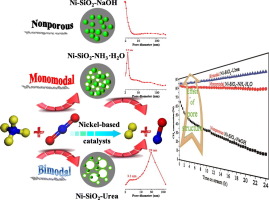当前位置:
X-MOL 学术
›
Fuel Process. Technol.
›
论文详情
Our official English website, www.x-mol.net, welcomes your
feedback! (Note: you will need to create a separate account there.)
Design of active and stable bimodal nickel catalysts for methane reforming with CO 2
Fuel Processing Technology ( IF 7.2 ) Pub Date : 2018-07-01 , DOI: 10.1016/j.fuproc.2018.03.032 Baitao Li , Xiaorong Lin , Yao Luo , Xiaoqing Yuan , Xiujun Wang
Fuel Processing Technology ( IF 7.2 ) Pub Date : 2018-07-01 , DOI: 10.1016/j.fuproc.2018.03.032 Baitao Li , Xiaorong Lin , Yao Luo , Xiaoqing Yuan , Xiujun Wang

|
Abstract Dry reforming of methane (DRM) has been investigated in numerous studies as an attractive process to produce synthesis gas. Although nonprecious-metal catalysts are widely employed in this reaction, their large scale application has been hampered due to difficulties in controlling the metal sintering and coking. The main objective of this research was to improve DRM reaction through highly active and effective nickel catalysts with bimodal structure. In this work, the effect of pore structures (nonporous, monomodal and bimodal structures) on the catalytic performance, stability and coke formation were comparatively discussed. Two series of nickel catalysts were developed by one-step and impregnation methods. By using one-step strategy, three kinds of bases (NH 3 ·H 2 O, Urea and NaOH) were used to prepare monomodal (Ni-SiO 2 -NH 3 ·H 2 O), bimodal (Ni-SiO 2 -Urea) and non-porous (Ni-SiO 2 -NaOH) catalysts. By using impregnation method, monomodal (Ni/M-SiO 2 ) and bimodal (Ni/B-SiO 2 ) catalysts were prepared. The pore structure exerted crucial effect on the catalytic performance in DRM. In comparison to monomodal catalyst, in each series bimodal nickel catalyst exhibited higher activity and more stable performance in DRM. The non-porous Ni-SiO 2 -NaOH exhibited inferior activity to the monomodal or bimodal catalyst due to the significant decrease in surface area. The obtained catalysts prepared by one step method contained Ni nanoparticles with diameter of 3 nm, about 1/8 of the catalysts prepared by impregnation method. Ultraviolet-visible diffuse reflectance spectroscopy (UV–Vis DRS) confirmed the well-dispersed Ni particles were incorporated into the silica framework. Temperature programmed reduction and X-ray photoelectron spectroscopy (XPS) also verified the strengthened interaction between Ni species and silica support. Thus, these structural properties led to higher activity over Ni-SiO 2 -Urea than the corresponding catalyst with equivalent pore structure. Relative to the initial methane conversion of 74% over Ni/B-SiO 2 , Ni-SiO 2 -Urea catalyst showed both stable CH 4 and CO 2 conversions and a constant H 2 /CO ratio close to 1, without significant decay of the activity during 24 h on stream.
中文翻译:

CO 2 甲烷重整活性稳定双峰镍催化剂的设计
摘要 甲烷干法重整 (DRM) 已在众多研究中作为一种有吸引力的合成气生产工艺进行了研究。尽管非贵金属催化剂在该反应中得到广泛应用,但由于难以控制金属烧结和焦化,阻碍了其大规模应用。本研究的主要目的是通过具有双峰结构的高活性和有效镍催化剂来改善 DRM 反应。在这项工作中,比较讨论了孔结构(无孔、单峰和双峰结构)对催化性能、稳定性和焦炭形成的影响。通过一步法和浸渍法开发了两个系列的镍催化剂。采用一步法,采用三种碱(NH 3 ·H 2 O、尿素和NaOH)制备单峰(Ni-SiO 2 -NH 3 ·H 2 O),双峰(Ni-SiO 2 -Urea)和无孔(Ni-SiO 2 -NaOH)催化剂。采用浸渍法制备了单峰(Ni/M-SiO 2 )和双峰(Ni/B-SiO 2 )催化剂。孔结构对DRM中的催化性能产生了至关重要的影响。与单峰催化剂相比,各系列双峰镍催化剂在DRM中表现出更高的活性和更稳定的性能。由于表面积的显着降低,无孔Ni-SiO 2 -NaOH 表现出比单峰或双峰催化剂较差的活性。一步法制备得到的催化剂含有直径为3nm的Ni纳米颗粒,约为浸渍法制备催化剂的1/8。紫外-可见漫反射光谱 (UV-Vis DRS) 证实分散良好的 Ni 颗粒已结合到二氧化硅框架中。程序升温还原和 X 射线光电子能谱 (XPS) 也证实了 Ni 物质与二氧化硅载体之间的相互作用增强。因此,与具有等效孔结构的相应催化剂相比,这些结构特性导致对Ni-SiO 2 -Urea 更高的活性。相对于 Ni/B-SiO 2 上 74% 的初始甲烷转化率,Ni-SiO 2 -尿素催化剂表现出稳定的 CH 4 和 CO 2 转化率以及接近 1 的恒定 H 2 /CO 比,没有显着衰减24 小时内的活动。
更新日期:2018-07-01
中文翻译:

CO 2 甲烷重整活性稳定双峰镍催化剂的设计
摘要 甲烷干法重整 (DRM) 已在众多研究中作为一种有吸引力的合成气生产工艺进行了研究。尽管非贵金属催化剂在该反应中得到广泛应用,但由于难以控制金属烧结和焦化,阻碍了其大规模应用。本研究的主要目的是通过具有双峰结构的高活性和有效镍催化剂来改善 DRM 反应。在这项工作中,比较讨论了孔结构(无孔、单峰和双峰结构)对催化性能、稳定性和焦炭形成的影响。通过一步法和浸渍法开发了两个系列的镍催化剂。采用一步法,采用三种碱(NH 3 ·H 2 O、尿素和NaOH)制备单峰(Ni-SiO 2 -NH 3 ·H 2 O),双峰(Ni-SiO 2 -Urea)和无孔(Ni-SiO 2 -NaOH)催化剂。采用浸渍法制备了单峰(Ni/M-SiO 2 )和双峰(Ni/B-SiO 2 )催化剂。孔结构对DRM中的催化性能产生了至关重要的影响。与单峰催化剂相比,各系列双峰镍催化剂在DRM中表现出更高的活性和更稳定的性能。由于表面积的显着降低,无孔Ni-SiO 2 -NaOH 表现出比单峰或双峰催化剂较差的活性。一步法制备得到的催化剂含有直径为3nm的Ni纳米颗粒,约为浸渍法制备催化剂的1/8。紫外-可见漫反射光谱 (UV-Vis DRS) 证实分散良好的 Ni 颗粒已结合到二氧化硅框架中。程序升温还原和 X 射线光电子能谱 (XPS) 也证实了 Ni 物质与二氧化硅载体之间的相互作用增强。因此,与具有等效孔结构的相应催化剂相比,这些结构特性导致对Ni-SiO 2 -Urea 更高的活性。相对于 Ni/B-SiO 2 上 74% 的初始甲烷转化率,Ni-SiO 2 -尿素催化剂表现出稳定的 CH 4 和 CO 2 转化率以及接近 1 的恒定 H 2 /CO 比,没有显着衰减24 小时内的活动。











































 京公网安备 11010802027423号
京公网安备 11010802027423号